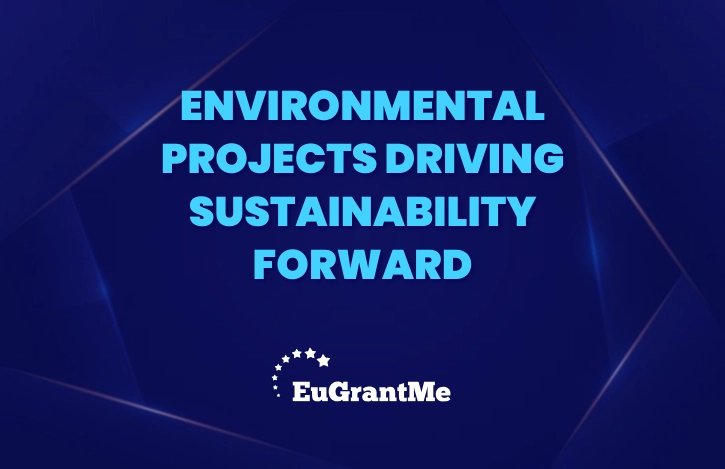The world is facing urgent environmental challenges. From climate change to biodiversity loss, the pressure is mounting. Across sectors, environmental projects are rising to the occasion. They are not just short-term solutions. They are long-term commitments to drive sustainability forward.
The shift is no longer optional. Governments, businesses, and communities recognise the need for decisive action. Environmental projects now stand at the centre of this response. They connect science, technology, and local knowledge. They also support sustainable development and resilience. As global goals push for carbon neutrality and resource efficiency, these initiatives have become the tools to achieve them.
Building Stronger Ecosystems
Healthy ecosystems are vital. They provide clean air, fresh water, fertile soil, and climate regulation. Yet, human activity continues to strain them. Environmental projects aim to repair, conserve, and enhance these natural systems.
From reforestation to wetland restoration, these efforts restore ecological balance. But more than that, they empower communities. Local involvement strengthens environmental stewardship and promotes equity.
These projects also address habitat fragmentation and promote biodiversity corridors. By creating interconnected spaces, they allow wildlife to thrive. This resilience is essential for species survival and ecological stability.
Energy Transitions with Purpose
Energy is a cornerstone of sustainability. Traditional sources rely heavily on fossil fuels. They release greenhouse gases and cause long-term environmental damage.
Environmental projects are leading the energy shift. Solar, wind, hydro, and bioenergy solutions are being deployed in smart, scalable ways. These alternatives reduce carbon emissions and increase energy independence.
In rural areas, decentralised systems bring clean power to off-grid communities. In cities, large-scale solutions are integrated into urban infrastructure. Crucially, these projects are designed to last. They combine renewable technology with energy efficiency. The result is a more resilient, reliable, and responsible energy future.
Smarter Cities, Cleaner Air
Urban areas face a double challenge. They are major sources of emissions and vulnerable to climate risks. But they also offer unique opportunities for innovation.
Environmental projects in cities target pollution, congestion, and waste. In this context, they promote greener transport, better waste management, and urban greening. Green roofs and walls reduce urban heat islands. Tree planting improves air quality. Efficient lighting and sustainable mobility reduce energy use and emissions.
All these efforts improve life quality. They also protect public health and enhance social cohesion. When designed inclusively, green cities become safer and more accessible for everyone.
Sustainable Water Management
Water is a finite resource. Yet, it is often taken for granted. Pollution, overuse, and climate change threaten its availability.
Environmental projects focus on protecting and managing water sources. They address river restoration, groundwater recharge, and rainwater harvesting. They also support wastewater treatment and safe reuse. These solutions preserve ecosystems and ensure long-term supply. They also help communities adapt to droughts and floods.
Integrated approaches work best. Combining natural and engineered systems leads to greater efficiency. It also supports ecosystem-based adaptation, which enhances climate resilience.
Rethinking Agriculture and Land Use
Agriculture supports billions of people. But it also contributes to deforestation, emissions, and water depletion.
Environmental projects are transforming land use practices. They promote agroecology, organic farming, and precision agriculture. These methods reduce inputs, protect soil, and enhance yields. They also support rewilding and sustainable grazing. This prevents land degradation and restores natural cycles.
By working with nature, farmers build long-term resilience. They also create new income sources through eco-certification and carbon farming. These shifts drive rural development while protecting the planet.
Circular Economy and Waste Solutions
Waste is a global problem. Linear models of production and consumption are no longer viable. Environmental projects now promote circular economy approaches. These projects focus on redesigning systems. They encourage reuse, repair, recycling, and regeneration. They also tackle industrial waste and packaging through innovation. For example, industrial symbiosis connects businesses so that one’s waste becomes another’s input. Composting and biogas generation close the organic loop.
The circular model also influences product design. Products are created with their end-of-life in mind. This reduces waste and promotes sustainability across entire value chains.
Empowering Communities and Inclusion
Environmental sustainability is not only technical. It is also social. Projects that drive lasting change involve people at every stage.
Environmental projects work best when they are inclusive. They engage women, youth, and Indigenous communities. They respect traditional knowledge and adapt to local contexts. Also, community-led initiatives strengthen trust and ensure relevance. In addition, they enhance outcomes and accountability.
Moreover, environmental justice is a key component. Projects must ensure that benefits and responsibilities are shared fairly. Only then can they achieve sustainable and equitable outcomes.
Leveraging Digital Tools and Data
Digitalisation is reshaping environmental action. Projects now use real-time data, AI, and IoT to monitor, predict, and manage resources. Smart sensors track air quality, water flow, and biodiversity. Drones and satellites support environmental assessments. Machine learning identifies patterns and risks. These tools improve decision-making and efficiency. They also provide early warning systems for disasters.
Data sharing also matters. Open platforms enable collaboration and transparency. They allow citizens, scientists, and policymakers to align efforts.
With the right safeguards, digital tools make environmental projects more precise, responsive, and effective.
Policy Support and Global Goals
Strong policies make environmental projects possible. Governments set the frameworks that guide and incentivise action.
In this context, environmental legislation, tax incentives, and green procurement shape investment decisions. They also send clear signals to the market. Furthermore, projects aligned with the UN Sustainable Development Goals (SDGs) and the Paris Agreement gain traction. These goals provide structure and urgency.
Public-private partnerships also play a role. They combine finance, innovation, and implementation power. These partnerships scale up impact and accelerate progress.
Measuring What Matters
Impact must be measured. Environmental projects need to show results and not just intentions.
Indicators vary by sector. They include emissions avoided, biodiversity restored, water saved, or waste diverted. Social indicators also matter—jobs created, equity improved, or resilience built.
Regular monitoring and evaluation keep projects on track. It also helps refine methods and share lessons. Additionally, transparency builds credibility. Clear communication of results fosters support and replicability. Effective measurement hence turns success into a model. It also ensures that sustainability is more than a slogan.
Financing the Transition
Funding remains a challenge. But solutions exist. Environmental projects can access climate finance, green bonds, and innovation grants.
First, multilateral banks, governments, and impact investors are increasing support. They seek projects with clear environmental and social value. Moreover, blended finance models reduce risks and attract private capital. These models combine public funds with market-based instruments. In addition, financial institutions assess environmental, social, and governance (ESG) performance. This pushes companies and cities to align with sustainability goals.
Long-term thinking is crucial. Environmental projects need stable support to deliver deep, lasting impact.
Creating a Culture of Sustainability
Sustainability is not just about projects. It’s about mindset. Environmental projects often inspire broader change. They shift behaviours and create momentum. They show what’s possible and why it matters. This culture change is essential. It encourages responsibility, creativity, and hope.
Education and communication reinforce it. Schools, media, and public campaigns play their part. They connect individuals to global efforts and local solutions. And when people feel part of the change, they act. That’s how sustainability becomes a shared journey.
Moving Towards a Greener Tomorrow
Environmental projects are shaping a better future. They repair nature, empower people, and build economic resilience. They also show that sustainability is achievable. Whether through reforestation, renewable energy, or zero-waste strategies, these projects make the vision of a green world real.
However, more work is needed. The climate crisis is accelerating. Biodiversity continues to decline. Resource scarcity is growing. Now, more than ever, we must scale up solutions. We must support innovation and share responsibility. And we must keep environmental projects at the centre of our response. Environmental projects are not just a trend. They are a necessity. They are how we move forward—together, and in balance with nature.
At EuGrantMe, we are passionate about fostering innovation and empowering ambitious minds to flourish. Our mission revolves around providing top-notch grant writing services for the EIC Accelerator and Horizon grants in Europe. We enable our customers to unlock the full potential of their ground-breaking ideas.
Do you have a project to turn into reality?
Contact us!


